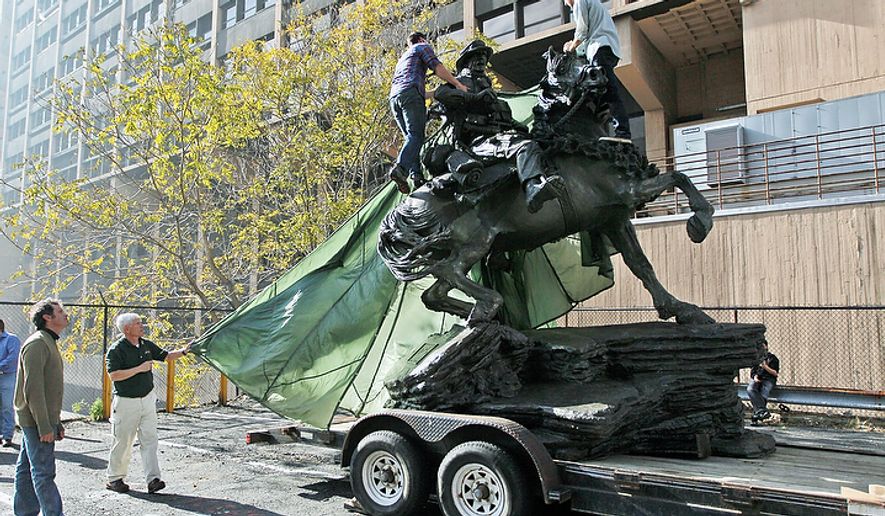NORMAN, Okla. — The first statue near ground zero to salute the heroes of the Sept. 11 terrorist attacks will not depict a New York firefighter or policeman — but a lone U.S. commando on horseback in the Afghan mountains.
Titled “De Oppresso Liber” — “to free the oppressed,” the Green Berets’ motto — the 3-ton, 18-foot-tall bronze monument was forged to honor the troops who first responded to al Qaeda’s attack from its safe haven in Afghanistan.
A piece of steel from the World Trade Center is embedded in its base, which bears the words “America’s Response Monument.” The statue was expected to be unveiled during the national Veterans Day Parade in New York on Nov. 11.
Its artist, Douwe Blumberg, was inspired in part by a photo of commandos on horseback in Afghanistan that Defense Secretary Donald H. Rumsfeld displayed during a news conference in late 2001.
“The visual irony of a 21st-century, high-tech trooper mounted on a ragged Afghan mountain horse, unchanged for centuries, fascinated me,” said Mr. Blumberg, who incorporated the stories of four of the first horseback commandos as he cast the statue in Norman.
“No one man did it, no one horse did it, no one commander did it. It was a collective mission,” Army Sgt. 1st Class Joe Jung, a Green Beret medic and sniper, told the artist.
Three teams of “killer elite” — a total of 34 U.S. commandos on horses — were tasked with something without precedent: orchestrating tribal warfare against the Taliban, al Qaeda’s protector in Afghanistan. They led the Northern Alliance, a group of warlords and freedom fighters, into combat against the Taliban and directed laser-guided U.S. airstrikes against the regime.
“These are the guys that, if it’s impossible, they’ll excel. And that’s what they did,” said retired Lt. Col. Max Bowers, their Special Forces ground commander.
The modern commandos even witnessed a cavalry charge: “Horses start rolling, bombs go off, except instead of sabers being swung, it was AK-47s,” said retired Master Sgt. Chris Spence, who took the famous photo Mr. Rumsfeld displayed to the press.
“American sentiment was: ’We need to get those bastards,’ ” Sgt. Spence added. “That was the bottom line.”
For Sgt. Jung, the medic, that meant continuing the mission with a broken back after his horse slipped in the treacherous mountains and fell on top of him in the first days of their mission.
“Two shots of morphine to relieve the pain and get back on the horse. I would not allow myself to be the weak link. It’s not in my nature, and it’s not in any Green Beret’s nature,” said Sgt. Jung, who currently is serving at Army Special Operations Command.
Col. Bowers, who chose each commando for this secret mission, always carried with him a piece of the World Trade Center while he advised Northern Alliance warlords during violent battles in Mazar-e-Sharif and Kunduz.
“We were almost slaughtered. It could have become a massacre,” he said.
Their Air Force combat controller — Master Sgt. Bart Decker, now retired — radioed for airstrikes, calling in bombing coordinates to a female navigator on an AC-130 gunship nicknamed “the Angel of Death.”
“The warlord we were advising heard her on my radio and broadcast to the enemy: ’Female up in this airplane is wreaking havoc on you,’ ” Sgt. Decker recalled. “That’s an insult, obviously, to the Taliban, who used to beat down their women.”
After the Taliban fell, the commandos buried Col. Bowers’ fragment of the World Trade Center in Afghanistan. “We did that because the [reason for] sending U.S. forces to Afghanistan was that 9/11 attack — and New York’s firefighters, police and emergency responders had done such a great job,” the colonel said.
Two New York firefighters witnessed the ceremony.
“We went over to thank them. They even wore our baseball caps,” said Monsignor John Delendick, a chaplain for New York’s fire department. “It impressed me that they gathered with us, even though they risked blowing their cover. We were the first soldiers in the war against terror and took a beating at the World Trade Center. These soldiers took it from there.”
In forging the statue, Mr. Blumberg paid attention to the commandos’ stories and included tiny details: In the tread of the soldier’s boots are pieces of gravel from Afghanistan that a Green Beret gave the artist for inspiration.
Another detail: On the soldier’s left hand is the outline of a wedding band under his glove. “That’s my way of tipping my hat to wives, marriages and strain on families,” Mr. Blumberg said. “It’s to acknowledge the stresses caused by multiple deployments.”
The statue will be located temporarily at One World Financial Center until its final installment near ground zero. A group of 9/11 survivors from Wall Street, who asked to remain anonymous, paid for the statue’s creation, and no public funds were used.
On Nov. 12, Army Lt. Gen. John Mulholland, commander of Special Operations Command, will present to New York Fire Commissioner Salvatore Cassano a map showing where the commandos buried that piece of the World Trade Center in Afghanistan.




Please read our comment policy before commenting.